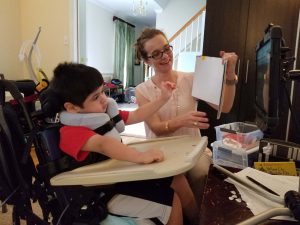 In June, Joey’s Foundation hosted Dr. Karen Pryor for a neuroplasticity seminar. This is the second post in a series about neuroplasticity. For last week’s post click here.
In June, Joey’s Foundation hosted Dr. Karen Pryor for a neuroplasticity seminar. This is the second post in a series about neuroplasticity. For last week’s post click here.
One aspect of her talk that struck me was the importance of connecting through the sensory system. Prior to my experience with the neuro-developmental approach in DIR/Floortime, most of my training had been behavioral based – where I had been taught to not take the sensory system into account. I was trained to be aware and understanding of a child’s specific sensory needs, but to work to override these preferences so that the sensory system did not interfere with a child’s learning. The neuro-developmental approach of DIR/Floortime, or as Dr. Pryor describes in neuroplasticity – is the opposite of this. To truly reach children and re-wire the brain, we must engage the sensory and nervous system.
Dr. Pryor compared the nervous system to a lamp – it must be plugged in in order to work. And in order to plug in the brain and turn it on, we must do the exercises and work that will flip the switch to turn the brain on.
How do we do this? We engage the sensory system.
In her book, Dr. Pryor writes “Sensory stimulation through primary senses reaches the nervous system quickly and in an orderly fashion. The information sent into the nervous system is processed quickly and determines motor skills that need to be engaged in response…. When we deliver sensory information and experiences to the child in this fashion (repeated sequences), the brain can process and learn more quickly.”
How do we engage the sensory system?
That answer is too long for one blog post (although I can recommend several books you can read if you are interested). Part of this work for us is to recognize the child’s individual sensory system and processing, and moving from there. We can engage the child’s preferences and strengths – perhaps hearing – with the child’s needs – vision. Pairing a visual and auditory stimulation will engage both systems and allow the two systems to wire together.
What does this mean for Joey?
With me, the work he does is within his face, head, neck, and arms. In order to answer questions and talk with me, Joey must be able to hold his head still and visually track the screen. In order to hold his head still, he needs to feel full control over his head, face, trunk, and neck. Dr. Pryor recommended giving Joey a head, face, and neck massage before starting work. This draws Joey’s attention to these parts of his body, and connects his senses with these parts of his face. The more attention, awareness, and alertness in these body parts, the more successful and alert Joey will be.
My struggle here, is that when I asked Joey if I could rub his face and neck he said “no”. I want to respect his limits because he has enough people touching him all the time when he does not have a choice. Since there are some people we are more comfortable with touching us than others, I let other caretakers work with this stimulation.
I struggle with this because when I was in physical therapy a year ago for a broken ankle, I remember feeling uncomfortable with some of the physical touch. Of course, that’s exactly what I needed, and I soon got over the uncomfortableness and appreciated the work. On the other hand, I am able to verbally express myself easily, and can tell someone to stop if needed. Joey doesn’t have that ability, so in this case I’ll honor his request and let someone else do the “wake up” massage.


